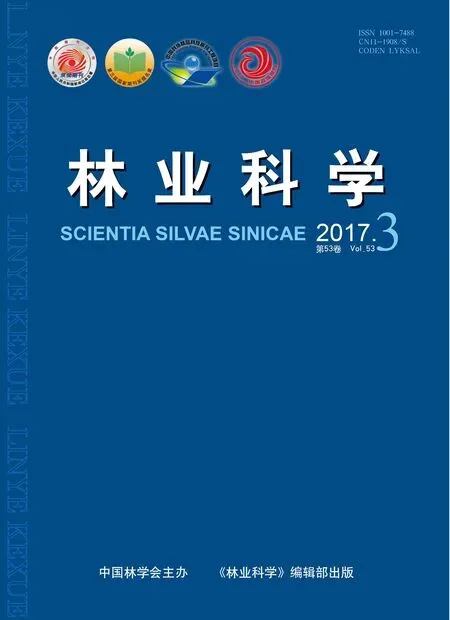容器规格和基质配方对红锥幼苗生长及造林效果的影响*
陈 琳 曾 杰 贾宏炎 蒙彩兰 黎 明
(1. 中国林业科学研究院热带林业实验中心 凭祥 532600; 2. 中国林业科学研究院热带林业研究所 广州 510520)
容器规格和基质配方对红锥幼苗生长及造林效果的影响*
陈 琳1曾 杰2贾宏炎1蒙彩兰1黎 明1
(1. 中国林业科学研究院热带林业实验中心 凭祥 532600; 2. 中国林业科学研究院热带林业研究所 广州 510520)
【目的】通过对不同容器规格和基质配方条件下1,2年生红锥幼苗生长及造林效果对比分析,为2种年龄红锥苗木培育筛选出适宜的容器规格和基质配方,亦为其造林适宜苗龄的选择提供科学依据。【方法】采用2种容器规格和11种基质配方分别培育1,2年生红锥苗,测定红锥苗期的生长动态,并开展造林试验,调查其早期生长表现。运用方差分析、多重比较等方法,探明不同容器规格和基质配方条件下红锥幼苗生长差异,应用相关分析揭示红锥苗期生长与造林效果的相关性。【结果】容器规格和基质配方显著影响1,2年生红锥苗的苗高、地径、根生物量和总生物量 (P<0.05),且两者交互作用对1,2年生幼苗的苗高、地径、根生物量以及2年生幼苗的总生物量具有显著影响。1年生红锥苗造林当年,各基质配方的造林保存率差异不显著 (P>0.05),而幼树高差异显著; 造林第2年,各基质配方的造林保存率和幼树高差异不显著,而地径差异显著。2年生红锥苗造林当年,各容器规格的造林保存率、幼树高和地径均差异显著,各基质配方的造林保存率差异不显著,而幼树高和地径差异显著。容器规格和基质配方的交互作用对2年生红锥苗造林当年幼树高具有显著影响。1年生红锥苗造林,当年幼树高、第2年幼树高和地径与造林前苗高、地径、根生物量和总生物量呈显著正相关,且当年和第2年幼树高与造林前幼苗根冠比呈显著负相关。2年生红锥苗造林,容器规格1(8 cm×12 cm, 直径×高)当年幼树高、地径与造林前苗高和总生物量呈显著正相关,容器规格2(12 cm×15 cm, 直径×高)当年幼树高与造林前苗高、地径、根生物量和总生物量呈显著正相关,而当年幼树地径与造林前总生物量呈显著正相关,表明红锥苗木质量显著影响其前两年造林效果。【结论】容器规格与基质配方对1,2年生红锥苗木生长存在交互作用,因此红锥苗期适宜基质配方选择应依据苗龄和容器规格而定。培育1年生红锥苗,建议采用容器规格1和基质配方10 (50%沤制树皮+25%黄心土+25%锥林表土); 培育2年生红锥苗则采用容器规格2和基质配方7 (50%沤制树皮+50%锥林表土)。在杂灌控制及时的良好立地,采用容器规格1培育1年生红锥苗,其造林效果优于容器规格2培育的2年生红锥苗。
红锥; 苗龄; 苗木质量; 生长动态; 造林效果
随着我国生态公益林、珍贵用材林基地建设、针叶林阔叶化改造等一系列林业工程的实施,我国对容器苗数量和质量的要求不断提高,而容器规格和基质配方是提高容器苗质量的2个重要手段 (邓华平等, 2011)。容器规格影响苗木根系对养分和水分的吸收面积,进而影响苗木形态、生理特性以及早期造林生长表现 (Aphaloetal., 2003; Dominguez-Lerenaetal., 2006; Closeetal., 2010)。物理化学性质稳定、持水性和透气性良好的基质配方有利于促进苗木生长 (邓煜等, 2000; 林霞等, 2010; 毛世忠等, 2011; da Silvaetal., 2014)。虽然国内外已经开展许多树种的容器规格或基质配方研究,然而适宜的容器规格和基质配方往往因树种而异,且容器规格和基质配方之间存在交互作用 (金国庆等, 2005; Geplyetal., 2011; 周志春等, 2011)。因此有必要针对某一树种开展容器苗的容器规格和基质配方研究。此外,国内关于容器规格和基质配方的研究中,往往缺少对苗木造林效果的评价,容易造成苗木培育与造林生产脱节,不利于容器苗的质量评价 (乌丽雅斯等, 2004; 许飞等, 2013)。
红锥 (Castanopsishystrix) 是我国热带和亚热带地区重要的乡土阔叶树种,为菌根营养型树种,其幼树耐荫,材质坚重、纹理直、耐腐、易加工,在用材林、水源林和薪炭林建设中具有重要地位 (陈应龙等, 2001)。随着红锥种植规模的不断扩大,尤其是红锥被广泛应用于生态公益林的营建和改造,其壮苗培育研究日益受到重视。目前,已经开展1年生红锥容器苗基质初步筛选以及2年生红锥容器苗容器规格、基质配方和施肥研究 (黎明等, 2006; 温恒辉等, 2012)。但是对于2种苗龄红锥苗木质量差异尚不清楚,而苗龄是影响苗木造林效果的重要因素 (Johanssonetal., 2007; 李国雷等, 2012)。因此,本研究设置2种容器规格和11种基质配方分别培育1年生和2年生红锥苗,比较不同容器规格和基质配方条件下红锥容器苗生长以及造林早期生长表现,旨在筛选适宜的容器规格和基质配方,并为红锥造林适宜苗龄的选择提供科学依据。
1 材料与方法
1.1 苗圃阶段
红锥芽苗购自广西壮族自治区林业科学研究院,为广西博白种源,高约4 cm。2012年4月8日,在中国林业科学研究院热带林业实验中心苗圃,开展不同容器规格和基质配方红锥苗生长对比试验。采用裂区试验设计 (表1),主区为11个基质配方,副区为容器规格,每个主小区在规格1 (8 cm×12 cm, 直径×高)和规格2 (12 cm×15 cm,直径×高) 无纺布袋内分别移栽75株和48株芽苗,重复3次,合计分别为2 475株和1 584株。移苗前,将黄心土、沤制树皮、炭化树皮、沤制锯末、锥林表土按照试验设计的比例充分混合,装入2种规格的无纺布袋中,置于15孔的塑料穴盘和50 cm×50 cm (长×宽) 的塑料盘中,育苗盘下方铺1层防草布以防止苗木根系穿入土壤。移苗后3个月内,根据天气情况对红锥苗进行遮荫处理。移苗1个月后开始施肥,前2个月淋施0.3%尿素 (氮≥46.4%),每周1次; 此后每周施1次0.5%复合肥 (硝态氮≥18%、络合型钾≥25%、螯合型中微量元素≥8%),至11月中旬为止; 翌年3月开始,淋施0.5%复合肥 (氮≥15%、五氧化二磷≥15%、氧化钾≥15%),每10天施1次,至10月底结束,2种容器规格红锥苗的施肥量保持一致。试验期间,每10~15天交替喷800~1 000倍的多菌灵或甲基托布津。
于2012年5月30日、7月4日、10月6日,2013年1月5日、4月17日、7月6日、8月12日、11月15日,2014年1月6日 (即移苗后第53,88,182,273,375,455,492,587,639天) 调查红锥苗高和地径 (前2次未调查地径)。2013年1月5日和2014年1月6日,每个小区分别选取有代表性的5株1年生和4株2年生红锥苗,将其分为根、茎、叶,于105 ℃杀青15 min,80 ℃烘48 h至恒质量,称量各组分干质量。

表1 基质配方
1.2 造林阶段
2013年1月和2014年2月,分别采用1年生红锥苗 (容器规格1) 和2年生红锥苗 (容器规格1和2) 在中国林业科学研究院热带林业实验中心伏波实验场的2块采伐迹地 (21°57′N, 106°47′E) 上营建对比试验林。试验地年均气温19.9 ℃,年均降雨量1 400 mm,海拔500 m。2块林地的立地条件基本一致,其土壤为花岗岩发育的红壤,土层厚度1 m以上。11个基质配方处理,每个小区种植20株,3次重复。穴规格为50 cm×50 cm×30 cm (长×宽×深),株行距分别为4 m×4 m和3 m×3 m,虽然造林密度不同,但是在造林前2年苗木尚未郁闭,密度效应尚未发生作用,因此不会对本研究结果造成影响。造林后每年进行2次灌草抚育。2013年8月30日和2014年11月25日,分别调查1年生和2年生红锥苗造林当年或第2年幼树保存率、高度和地径。
1.3 统计分析
应用SPSS16.0软件和One-way ANOVA程序分别对红锥苗期生长和造林效果进行多因素和单因素方差分析,检验容器规格和基质配方的主效应和交互效应,并进行Duncan多重比较。分别不同容器规格和苗龄,对不同基质配方处理的红锥苗期生长与其造林效果进行Pearson相关分析,评价苗木质量对造林效果的影响。在统计分析时,保存率 (百分比数据) 经平方根反正弦转换。
2 结果与分析
2.1 苗期生长
容器规格和基质配方的交互作用对1,2年生红锥苗高、地径、根生物量以及2年生红锥苗总生物量具有显著影响 (P<0.05),而对其他指标影响不显著 (P>0.05)。容器规格对1,2年生红锥苗高、地径、根生物量和总生物量均影响极显著 (P<0.01),而对根冠比则无显著影响。红锥1年生苗,容器规格2苗高、地径、根生物量和总生物量比容器规格1分别提高7%,5%,32%和28% (图1); 2年生苗,容器规格2苗高、地径、根生物量和总生物量比容器规格1分别提高50%,27%,147%和151% (图2)。
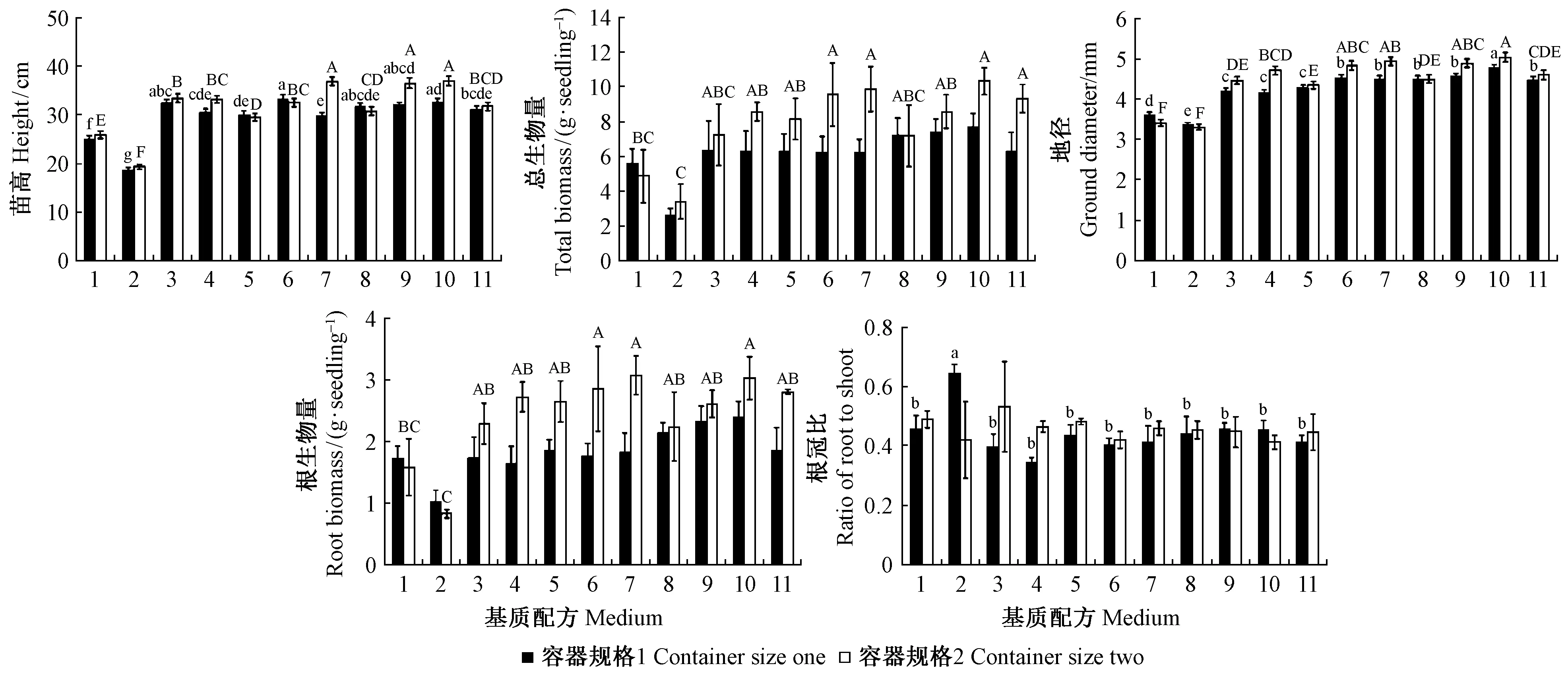
图1 容器规格和基质配方对1年生红锥苗生长的影响Fig.1 Container size and medium effects on the growth of one-year-old C. hystrix seedlings不同小写或大写字母表示在P<0.05水平上差异显著,误差线代表标准误,下同。Treatments without the same small or capital letter are significantly different between treatments for container size one or two according to Duncan’s multiple range tests at the 5% level. Error bars represent standard errors. The same below.
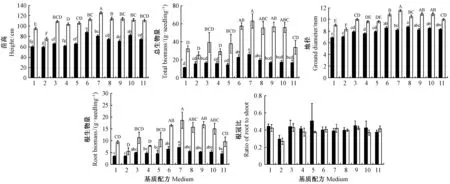
图2 容器规格和基质配方对2年生红锥苗生长的影响Fig.2 Container size and medium effects on the growth of two-year-old C. hystrix seedlings
无论苗龄和容器规格,各基质配方的红锥苗高和地径均差异极显著; 除用容器规格1培育的1年生红锥苗各基质配方的根生物量和总生物量差异不显著外,其他红锥苗各基质配方的生物量均差异极显著或显著; 对于根冠比而言,各基质配方大多无显著差异,仅容器规格1培育的1年生红锥苗根冠比基质配方2显著大于其他基质。在11种基质配方中,苗高、地径、根生物量和总生物量均以基质配方1或2为最小,而其最大值出现的基质配方则因容器规格和苗龄而异。如1年生红锥苗,容器规格1以10号基质配方的苗高和地径为最大,比2号基质分别提高74%和42%; 容器规格2以7,9,10号基质的苗高、地径、根生物量和总生物量为最大,比2号基质分别提高88%~92%,48%~53%,218%~275%和153%~204% (图1)。对于2年生红锥苗而言,容器规格1以6号基质配方的苗高、地径、根生物量和总生物量为最大,比1号基质分别提高44%,25%,92%和105%; 容器规格2以7号基质配方的苗高、地径、根生物量和总生物量为最大,比2号基质分别提高67%,39%,239%和151% (图2)。
苗高和地径分别在移苗后53~273天和182~273天生长缓慢,2种容器规格之间苗高和地径差异不显著; 移苗后275天,即约1年生时,2种容器规格之间红锥苗高和地径呈极显著差异; 移苗后587天,2种容器规格之间苗高和地径差异达到最大值,此后保持恒定 (图3)。

图3 2种容器规格红锥苗高和地径的动态变化Fig.3 Height and ground diameter dynamics of C. hystrix seedlings under two container sizes**表示在P<0.01水平上差异显著。**represents significant difference according to Duncan’s multiple range tests at the 1% level.
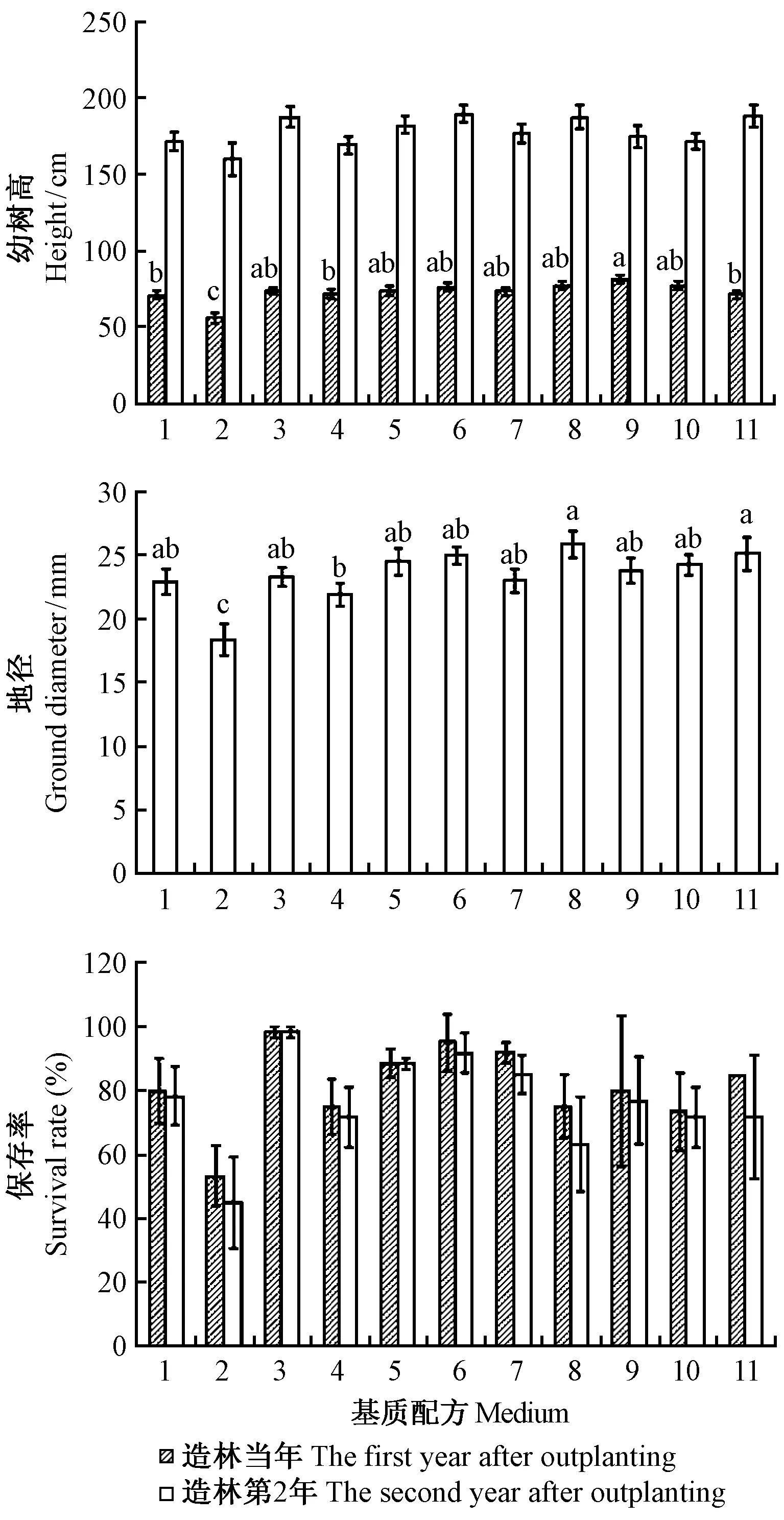
图4 1年生红锥苗(容器规格1)当年和第2年造林效果Fig.4 Field performance of one-year-old C. hystrix seedlings (container size one) in the first and second year after outplanting
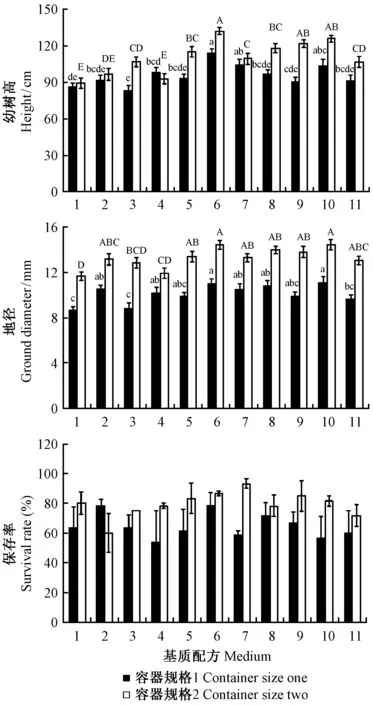
图5 2年生红锥苗当年造林效果Fig.5 Field performance of two-year-old C. hystrix seedlings in the first year after outplanting
2.2 造林效果
1年生红锥苗造林当年,11种基质配方的造林保存率差异不显著 (P>0.05),而幼树高差异极显著 (P<0.01),以2号基质配方幼树高最小,比其他基质低21%~31%; 造林第2年,各基质配方的保存率和幼树高差异均不显著,而地径差异极显著,以2号基质配方地径最小,比其他基质低16%~29% (图4)。
容器规格和基质配方的交互作用对2年生红锥苗造林当年幼树高具有显著影响,而对保存率和地径无显著影响(图5)。容器规格对造林保存率、幼树高和地径影响极显著,这3次指标容器规格2比容器规格1分别提高23%,16%和32%。无论哪种容器规格,不同基质配方保存率差异不显著,但其幼树高和地径差异极显著,均以1号基质配方为最小,而其最大值出现的基质配方则因容器规格而异。容器规格1,以6,7和10号基质配方的幼树高和地径最大,比1号基质配方分别高20%~32%和21%~28%; 容器规格2,以6,9和10号基质配方的幼树高和地径最大,比1号基质分别高37%~48%和18%~23% (图5)。采用容器规格1培育的1年生红锥苗,在造林第2年的生长表现与采用容器规格2培育的2年生红锥苗造林当年的生长表现相比较,其保存率无显著差异,但前者的平均幼树高和地径比后者分别提高60%和80% (图4,5)。
2.3 苗期生长与造林效果的相关分析
由表2可知,1年生红锥苗造林,当年和第2年幼树高与造林前苗高、地径、根生物量和总生物量呈显著正相关 (P<0.05),而与根冠比呈显著负相关; 第2年地径与造林前苗高、地径、根生物量和总生物量呈显著正相关,而与根冠比不相关; 当年和第2年保存率与造林前幼苗各项生长指标均不相关。
2年生红锥苗造林,容器规格1当年幼树高和地径与造林前苗高和总生物量呈显著正相关,而与其他生长指标不相关。容器规格2当年幼树高与造林前苗高、地径、根生物量和总生物量呈显著正相关,而与根冠比相关不显著; 当年地径与造林前幼苗总生物量呈显著正相关,而与其他生长指标相关不显著。2种容器规格,当年保存率与造林前幼苗各项生长指标均不相关 (表2)。
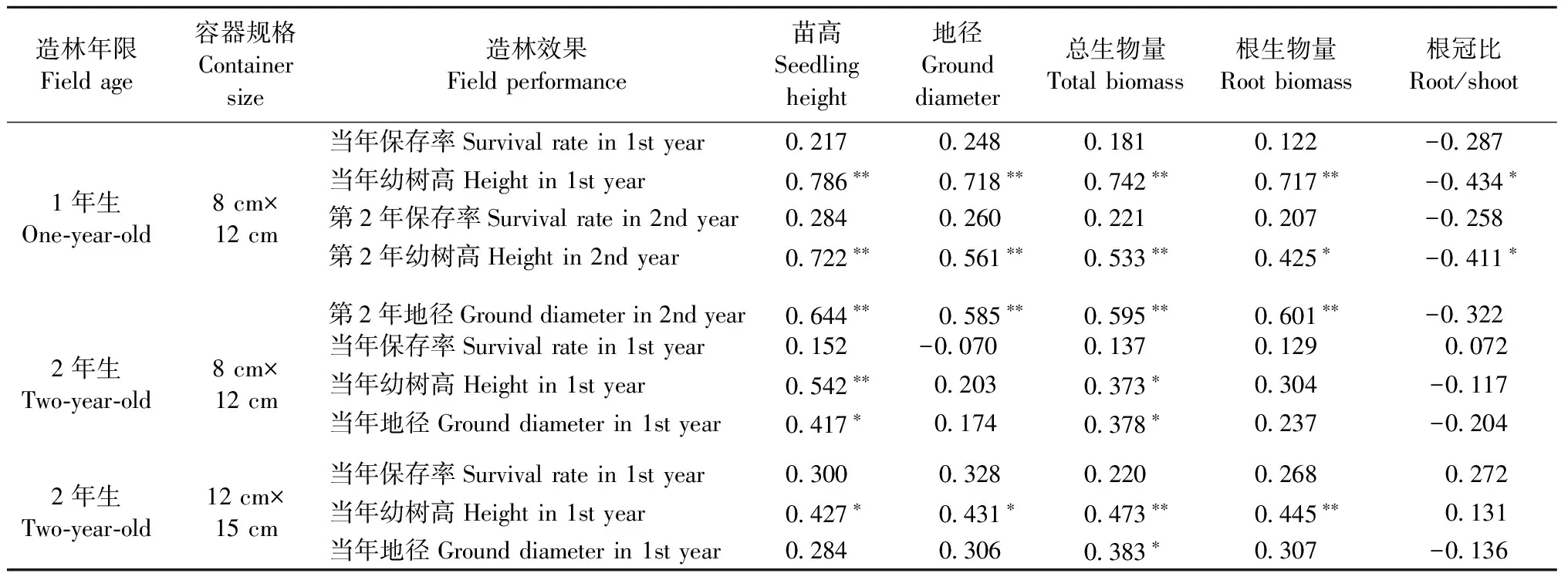
表2 红锥苗期生长与造林效果的相关性①
① 样本数为33,* and ** 分别表示在P<0.05和P<0.01水平上显著相关。n=33, * and ** represent the significance of Pearson’s correlation coefficient at the 5% and 1% level, respectively.
3 讨论
3.1 容器规格
1年生红锥苗,容器规格1的平均苗高、地径和总生物量分别为30 cm、4.3 cm和6.2 g,容器规格2的平均苗高、地径和每株总生物量分别为32 cm、4.6 cm和7.9 g,均已达到造林出圃标准 (黎明等, 2006),但是容器规格1所需材料少,基质相对较轻,可有效地降低育苗、运输和造林成本。小规格容器更易使苗木形成根团,有利于提高造林成活率; 相反,大规格容器的苗木根系密度较小,不利于形成根团,进而影响造林成活率 (李永胜等, 2007; 郑坚等, 2010),因此在满足生产需要的前提下宜选择容器规格1培育1年生红锥苗进行造林。2年生红锥苗,容器规格2的苗高、地径、根生物量和总生物量比容器规格1分别提高50%,27%,147%和151%,表明大规格容器更有利于苗木根系发育,从而促进苗木生长,特别是随着苗龄的增长,当根系生长量超过小规格容器承受范围时,大容器的促进效应越明显 (Southetal., 2005)。2年生红锥苗造林当年,容器规格2的造林保存率、幼树高和地径均显著高于容器规格1,可能与大规格容器更有利于苗木根系发育有关,容器规格2的根生物量比容器规格1高147%,亦说明采用容器规格2培育2年生红锥苗提高了苗木质量,进而促进了其造林当年的生长,因此宜选择体积较大的容器规格2培育2年生红锥苗。Aphalo等 (2003) 亦发现容器规格不仅影响欧洲白桦 (Betulapendula) 苗木生长和形态,而且影响其造林第5年的生长。然而,Close等 (2010) 研究表明虽然容器规格显著影响蓝桉 (Eucalyptusglobulus) 造林当年的生长,但对其造林第4年的生长无显著影响,这种差异可能与树种特性有关。本研究中,容器规格对2年生红锥苗造林当年保存率、幼树高和地径均有显著影响,但由于造林时间短,容器规格对红锥苗造林效果影响的时间效应将有待继续观测方能得出结论。
采用容器规格1培育1年生红锥苗和容器规格2培育2年生红锥苗,比较前者在造林第2年和后者在造林当年的生长发现,前者平均幼树高和地径分别比后者高60%和80%,说明采用容器规格1培育1年生红锥苗造林第2年的效果优于采用容器规格2培育2年生红锥苗造林当年的效果,可能因为小规格容器培育的苗木在立地适宜且杂灌控制良好的情况下,其生长速度高于大规格容器的苗木生长速度 (Renou-Wilsonetal., 2008; Closeetal., 2010)。但是在严寒环境或杂灌丛生的立地,宜选择抗性和竞争能力更强、规格较大苗木进行造林 (Johanssonetal., 2007)。因此,今后需开展红锥2种苗龄在不同立地条件下的造林对比试验,探讨苗龄、容器规格、立地条件等因素交互作用对红锥苗造林效果的影响 (Landisetal., 2006; Pintoetal., 2011)。
3.2 基质配方对幼苗生长和造林效果的影响
由于容器规格和基质配方显著影响1,2年生红锥苗高、地径、根生物量以及2年生红锥苗总生物量,因此建议在生产中红锥苗期适宜基质配方应依据苗龄和容器规格而定。比如采用容器规格1培育1年生红锥苗,适宜基质配方为10号 (50%沤制树皮+25%黄心土+25%锥林表土),与此前筛选的适宜基质配方 (75%黄心土+25%锥林表土+磷肥0.5%) 相比,其基质质量更轻,且红锥苗生长表现更佳 (黎明等, 2006)。采用容器规格2培育2年生红锥苗,适宜基质配方为7号 (50%沤制树皮+50%锥林表土),虽然与此前筛选的适宜基质配方 (50%砂质壤土+25%沤制松皮粉+25%炭化松树皮) 相比,其基质质量相近,但是红锥苗生长表现更佳 (温恒辉等, 2012),因此本研究获得了更适宜红锥育苗的基质配方。无论是苗龄还是容器规格,本研究的适宜基质配方中均含有锥林表土,这是因为基质配方中添加适当比例的锥林表土有利于菌根的形成,扩大了根系吸收水分和养分的面积,从而促进了红锥苗生长 (陈应龙等, 2001)。Kazantseva等 (2009) 亦发现在基质中添加适当比例的森林表土有助于促进道格拉斯冷杉 (Pseudotsugamenziesiivar.glauca) 幼苗根系形成菌根,降低了幼苗在水分胁迫下的死亡率。但是由于锥林表土资源有限,今后将加强红锥苗菌根菌接种研究 (skarsson, 2010; Repáetal., 2015)。进一步比较各基质配方的造林效果,发现10号和7号基质配方的造林效果亦良好,说明苗期筛选出的适宜基质配方经造林检验是可靠的。由红锥苗期生长与造林效果之间相关分析结果可知,红锥苗木质量显著影响其前2年的造林效果,无论是苗龄还是容器规格,苗高和总生物量可作为评价红锥苗早期造林效果的可靠和简易指标 (Southetal., 2005; Renou-Wilsonetal., 2008; Lietal., 2011)。
4 结论
容器规格与基质配方对1,2年生红锥苗木生长存在交互作用,因此红锥苗期适宜基质配方选择应依据苗龄和容器规格而定。综合红锥苗期生长和早期造林效果,培育1年生红锥苗,适宜采用容器规格1 (8 cm×12 cm,直径×高) 和基质配方10 (50%沤制树皮+25%黄心土+25%锥林表土); 培育2年生红锥苗,适宜采用容器规格2 (12 cm×15 cm,直径×高) 和基质配方7 (50%沤制树皮+50%锥林表土); 在杂灌控制及时且立地好的情况下,采用容器规格1培育的1年生红锥苗,其造林效果优于采用容器规格2培育的2年生红锥苗。
陈应龙, 弓明钦, 陈 羽, 等. 2001. 外生菌根菌接种对红椎生长及光合作用的影响. 林业科学研究, 14(5): 515-522.
(Chen Y L, Gong M Q, Chen Y,etal. 2001. Effects of inoculation with 11 ectomycorrhizal fungal isolates on growth and photosynthesis ofCastanopsishystrixsamplings. Forest Research, 14(5): 515-522. [in Chinese])
邓华平, 杨桂娟, 王正超, 等. 2011. 容器大苗培育技术研究现状. 世界林业研究, 24(2): 36-41.
(Deng H P, Yang G J, Wang Z C,etal. 2011. Research status on cultivating techniques of big container seedlings. World Forestry Research, 24(2): 36-41. [in Chinese])
邓 煜, 刘志峰. 2000. 温室容器育苗基质及苗木生长规律的研究. 林业科学, 36(5): 33-39.
(Deng Y, Liu Z F. 2000. Study on growing medium and growth law for containerized seedling stocks grown in greenhouse. Scientia Silvae Sinicae, 36(5): 33-39. [in Chinese])
金国庆, 周志春, 胡红宝, 等. 2005. 3种乡土阔叶树种容器育苗技术研究. 林业科学研究, 18(4): 387-392.
(Jin G Q, Zhou Z C, Hu H B,etal. 2005. Studies on container seedlings cultural techniques of three native broad-leaved tree species. Forest Research, 18(4): 387-392. [in Chinese])
李国雷, 祝 燕, 李庆梅, 等. 2012. 红松苗龄型对苗木质量和造林效果的影响. 林业科学, 48(1): 35-41.
(Li G L, Zhu Y, Li Q M,etal. 2012. Effect of seedling age on the seedling quality and field performance ofPinuskoraiensis. Scientia Silvae Sinicae, 48(1): 35-41. [in Chinese])
黎 明, 郭文福. 2006. 红锥容器苗基质试验简报. 广西林业科学, 35(1): 31-33.
(Li M, Guo W F.2006.Brief report ofCastanopsishystrixcontainer seedling medium trial.Guangxi Forestry Science,35(1):31-33. [in Chinese])李永胜, 朱锦茹, 江 波, 等. 2007. 乳源木莲管形容器育苗技术研究. 浙江林业科技, 27(2): 11-15.
(Li Y S, Zhu J R, Jiang B,etal. 2007. Study on technique for tube container seedling cultivation ofManglietiayuyuanensis. Journal of Zhejiang Forestry Science and Technology, 27(2): 11-15. [in Chinese])
林 霞, 郑 坚, 刘洪见, 等. 2010. 不同基质对无柄小叶榕容器苗生长和叶片生理特性的影响. 林业科学, 46(8): 62-70.
(Lin X, Zheng J, Liu H J,etal. 2010. Effects of different media on growth and leaf physiological characteristics ofFicusconcinnavar.subsessiliscontainer seedlings. Scientia Silvae Sinicae, 46(8): 62-70. [in Chinese])
毛世忠, 唐文秀, 骆文华, 等. 2011. 不同栽培基质对广西火桐幼苗生长及净光合速率的影响. 西北林学院学报, 26(5): 96-99.
(Mao S Z, Tang W X, Luo W H,etal. 2011. Effects of different substrates on seedling growth and net photosynthesis rate ofErythropsiskwangsiensis. Journal of Northwest Forestry University, 26(5): 96-99. [in Chinese])
温恒辉, 贾宏炎, 黎 明, 等. 2012. 基质类型、容器规格和施肥量对红椎容器苗质量的影响. 种子, 31(7): 75-77, 82.
(Wen H H, Jia H Y, Li M,etal. 2012. Effects of media type, container size and fertilizer quantity on growth and quality of container seedlings ofCastanopsishystrix. Seed, 31(7): 75-77, 82. [in Chinese])
乌丽雅斯, 刘 勇, 李瑞生, 等. 2004. 容器育苗质量调控技术研究评述. 世界林业研究, 17(2): 9-13.
(Wuli Y S, Liu Y, Li R S,etal. 2004. Reviewing on quality modification and control techniques of containerized seedling. World Forestry Research, 17(2): 9-13. [in Chinese])
许 飞, 刘 勇, 李国雷, 等. 2013. 我国容器苗造林技术研究进展. 世界林业研究, 26(1): 64-68.
(Xu F, Liu Y, Li G L,etal. 2013. Research advances of container seedling afforestation techniques in China. World Forestry Research, 26(1): 64-68. [in Chinese])
郑 坚, 陈秋夏, 李效文, 等. 2010. 无柄小叶榕容器苗形态和生理质量评价指标筛选. 中国农学通报, 26(15): 141-148.
(Zheng J, Chen Q X, Li X W,etal. 2010. The screening of morphological and physiological indices for quality evaluation in container seedling ofFicusconcinnavar.subsessilis. Chinese Agricultural Science Bulletin, 26(15): 141-148. [in Chinese])
周志春, 刘青华, 胡根长, 等. 2011. 3种珍贵用材树种轻基质网袋容器育苗方案优选. 林业科学, 47(10): 172-178.
(Zhou Z C, Liu Q H, Hu G C,etal. 2011. Scheme optimization of light substrate for container seedlings of three precious timber tree species. Scientia Silvae Sinicae, 47(10): 172-178. [in Chinese])
Aphalo P, Rikala R. 2003. Field performance of silver-birch planting-stock grown at different spacing and in containers of different volume. New Forests, 25(2): 93-108.
Close D C, Paterson S, Corkrey R,etal. 2010. Influences of seedling size, container type and mammal browsing on the establishment ofEucalyptusglobulusin plantation forestry. New Forests, 39(1): 105-115.
da Silva R B G, da Silva M R, Simões D. 2014. Substrates and controlled-release fertilizations on the quality of eucalyptus cuttings. Revista Brasileira de Engenharia Agrícolae Ambiental, 18(11): 1124-1129.
Dominguez-Lerena S, Sierra N H, Manzano I C,etal. 2006. Container characteristics influencePinuspineaseedling development in the nursery and field. Forest Ecology and Management, 221(1): 63-71.
Geply O A, Baiyewu R A, Adegoke I A,etal. 2011. Effect of different pot sizes and growth media on the agronomic performance ofJatrophacurcas. Pakistan Journal of Nutrition, 10(10): 952-954.
Johansson K, Nilsson U, Allen H L. 2007. Interactions between soil scarification and Norway spruce seedling types. New Forests, 33(1): 13-27.
Kazantseva O, Bingham M, Simard S W,etal. 2009. Effects of growth medium, nutrients, water, and aeration on mycorrhization and biomass allocation of greenhouse-grown interior Douglas-fir seedlings. Mycorrhiza, 20(1): 51-66.
Landis T D, Dumroese R K. 2006. Applying the target plant concept to nursery stock quality∥Plant quality: a key to success in forest establishment. Proceedings of the COFORD Conference. Dublin, Ireland:National Council for Forest Research and Development, 1-10.
Li G L, Liu Y, Zhu Y,etal. 2011. Influence of initial age and size on the field performance ofLarixolgensisseedlings. New Forests, 42(2): 215-226.
Pinto J R, Marshall J D, Dumroese R K,etal. 2011. Establishment and growth of container seedlings for reforestation: a function of stocktype and edaphic conditions. Forest Ecology and Management, 261(11): 1876-1884.
Renou-Wilson F, Keane M, Farrell E P. 2008. Effect of planting stocktype and cultivation treatment on the establishment of Norway spruce on cutaway peatlands. New Forests, 36(3): 307-330.
South D B, Harris S W, Barnett J P,etal. 2005. Effect of container type and seedling size on survival and early height growth ofPinuspalustrisseedlings in Alabama, U.S.A. Forest Ecology and Management, 204(2): 385-398.
(责任编辑 王艳娜 郭广荣)
Effects of Container Size and Matrix Formula on Seedlings Growth and Early Field Performance ofCastanopsishystrix
Chen Lin1Zeng Jie2Jia Hongyan1Meng Cailan1Li Ming1
(1.ExperimentalCentreofTropicalForestry,CAFPingxiang532600; 2.ResearchInstituteofTropicalForestry,CAFGuangzhou510520)
【Objective】 The growth of one- and two-year-oldCastanopsishystrixseedlings raised with different media and different sizes of containers were compared, and their out-planted performances were also evaluated, aiming to determine the optimum container size and medium, as well as to provide guidance to selection of suitable seedling age for planting. 【Method】C.hystrixseedlings were raised in containers of two sizes with eleven media. Growth dynamics and early field performance were investigated, respectively. Variance analysis with Duncan’s multiple comparison was conducted to test differences in seedling growth and the early field performance among treatments, and correlation analysis was used to determine the relationship between seedling growth and early filed performance. 【Result】 Container size and growing medium significantly influenced height, root collar diameter, root and total biomass of one- and two-year-old seedlings. Moreover, their interaction significantly affected height, root collar diameter and root biomass of one- and two-year-old seedlings as well as total biomass of two-year-old seedlings. For one-year-old seedlings, there was significant difference in height but not in survival rate among media in the first year after out-planting. A significant difference was found in root collar diameter but not in height and survival rate in the second year after out-planting. For two-year-old seedlings, there were profound effects of container size and medium on height and root collar diameter in the first year after out-planting. Moreover, the interaction of container size and medium influenced obviously the height of two-year-old seedlings in the first year after planting. The height in the first year, and height and root collar diameter in the second year after planting showed positive relationships with the height, root collar diameter and total biomass of one-year-old seedlings in the nursery, respectively. However, the height in the first and second year after planting were negatively correlated with the root and shoot ratio in the nursery, respectively. As for two-year-old seedlings, with container size one, their height and root collar diameter at the first year after planting were positively correlated with the height and total biomass in the nursery separately, while with container size two, their height in the first year after planting had a positive relationship with their height, root collar diameter, root and total biomass in the nursery, while the root collar diameter in the first year after planting was positively correlated with total biomass in the nursery, suggesting that seedling quality significantly influenced the field growth performance of C. hystrix seedlings within first two years after planting. 【Conclusion】 The interaction of container size and medium had a profound effect on the seedling growth of one-year and two-year-oldC.hystrixseedlings, therefore the optimum medium should be selected according to different seedling ages and container sizes. Container size one (8 cm×12 cm, diameter × height) and medium ten (50% composted bark, 25% yellow soil and 25% surface soil) were recommended to raise one-year-oldC.hystrixseedlings, while container size two (12 cm×15 cm, diameter × height) and medium seven (50% composted bark and 50% surface soil) were suggested to raise two-year-old ones according to the seedling growth performance in nursery and after planting. It could be preliminarily concluded that under weed-controlled site, the field performance of one-year-oldC.hystrixseedlings with container size one in the second year after out-planting was better than those of two-year-old seedlings with container size two in the first year after planting.
Castanopsishystrix;seedling age;seedling quality; growth dynamics; field performance
10.11707/j.1001-7488.20170309
2016-01-19;
2016-04-11。
中国林业科学研究院基本科研业务费专项资金项目“珍贵树种轻基质工厂化育苗技术研究与示范”(CAFYBB2012048)。
S723.133
A
1001-7488(2017)03-0076-08
*贾宏炎为通讯作者。

